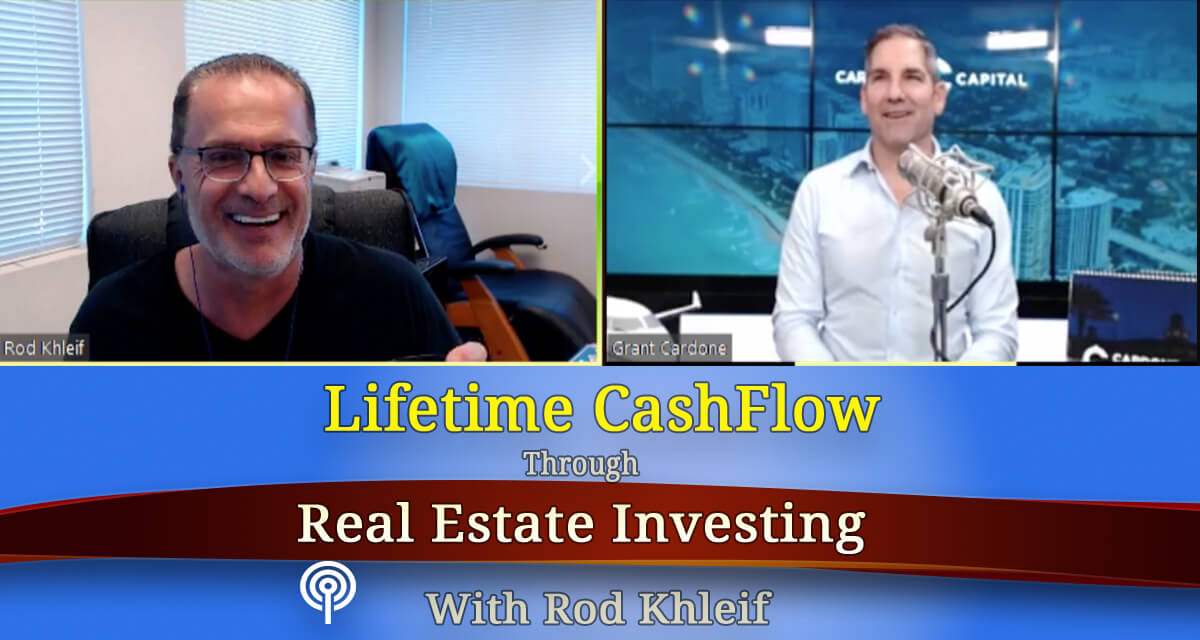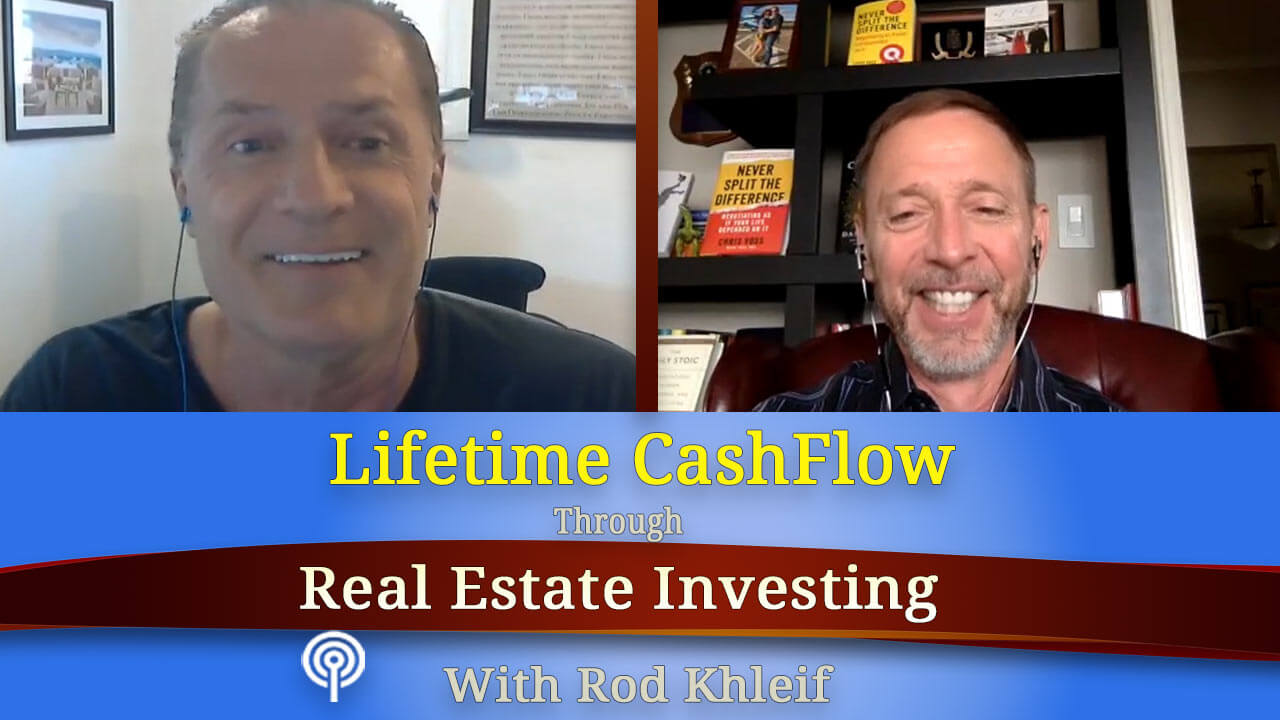Ep #229 – Joe Killinger and George Pino – A Socially Responsible Multifamily Investing Model
What you will learn:
Socially Responsible Real Estate Business Model
How to lower make-ready costs
How to evaluate multi family properties
Importance of understanding landlord – tenant laws
Cash per door vs cash flow
Why to look at Net operating income vs sales price
Understanding Proforma vs actuals
Why to create your own proforma
Normalizing the expenses
Tenant screening
The value of working with local law inforcement
Easy value add ons that make a difference
Increasing NOI
Opportunities for monthly upcharges
Importance of keeping up with the industry trends
Importance of understanding local trends and preferences
The value of “walking” your property
The value of professional property management software
To learn more about our guest, click here
Join us at a Multifamily Bootcamp, visit MultifamilyBootcamp.com
Full Transcript Below:
Ep #229 – Joe Killinger and George Pino – A Socially Responsible Multifamily Investing Model
Rod Khleif: Welcome to another edition of How to Build Lifetime Cash Flow Through Real Estate Investing. I’m Rod Khleif and I am thrilled you’re here. I know you’re gonna get tremendous value from the gentlemen were interviewing today.
Now, their names are Joe Killinger, and George Pino and they are with the theRRD.com, and we’re gonna dig in to what they do and why they do it and where they come from.
Welcome to the show, guys.
Joe Killinger: Thank you.
George Pino: Thanks for having us.
Rod Khleif: Absolutely. Maybe each of you can independently talk about how you got into the multifamily space, what you’ve done, and maybe why you love it.
Joe Killinger: Go ahead.
Geaorge Pino: Absolutely. This is George Pino speaking and I’ve been in real estate now for 31 years. When I originally got started in, I was actually doing brokerage and real estate auctions. And then we started…
I became business partners with Joe, back in 1993. Shortly thereafter, we started to purchase and acquire multifamily assets. And of course, all we could afford was really Class B, Class C assets in low-income neighborhoods.
We were in our 20s, starting to invest in Los Angeles…
Rod Khleif: Wow. That’s an expensive market.
George Pino: Buying properties… It’s an expensive market to get started in.
Rod Khleif: Right.
George Pino: Absolutely, and so a lot of what we did, going into smaller real estate assets, small apartment buildings. Purchasing our first six-unit, then a 10-unit, and then growing that in to a 28, then a 23, then a 52-unit. It kept growing.
Rod Khleif: All in LA?
Joe Killinger: Yes.
Rod Khleif: Wow.
George Pino: All in Los Angeles. And then we actually started to expand into Texas when the LA market got a little tough. One of the things that we did was, we’re always cash flow buyers. When the returns on the Los Angeles market were just pushing a little too low rather, or the prices were too high, we ended up looking at some other markets that we had some experience in.
We started purchasing in the Dallas, Texas sub-market and opening an office there as well.
Rod Khleif: Okay.
George Pino: That’s kinda what we did, we actually created social responsible real estate investment company back before that term was popular or even around, back in 2000…
Rod Khleif: What does it mean exactly? Socially responsible real estate company.
George Pino: You know what, we didn’t even call it that.
[chuckles]
George Pino: It was…
Joe Killinger: Tagged as…
George Pino: It ended up being tagged that by a professor in Arizona who had started a whole socially responsible real estate investing forum. It was great. We’re asked to be a part of that forum, and speak on their behalf.
We were able to speak after the Hurricane Katrina, as well as in New York, and a few things about how real estate investors can actually increase their cash flow, or income, by doing the right thing as well.
Rod Khleif: I love it.
George Pino: By just socially responsible investing.
Rod Khleif: Love it. So this is offering affordable solutions, or is it more philanthropic, or what is it?
George Pino: No. No. Our socially responsible investment company was called Learning Link Centers. And what we did was a business model that came from Joe, actually.
Joe’s from a small town in Nebraska, 281 people, and when he was growing up, whenever he needed help on any kind of education or math, he would go out and would just literally knock on the door of his schoolteacher, and talked to them after school.
We thought, how can we replicate that? So the Learning Links model that Joe came up with is, we would take a unit off the market, convert it into what we call a resource center, with computer, internet service, mini library with books and games. We’d also discount a percentage of the units in that building and then bring in accredited schoolteachers who would then tutor the kids that live in the building for four days a week, for two and a half hours a day.
Rod Khleif: Wow.
George Pino: For free.
Rod Khleif: Very, very cool.
Joe Killinger: Well, originally, it was not meant to be kind of philanthropic…
Rod Khleif: Yeah. No. Absolutely.
Joe Killinger: What it turned out to be is, as we learned… the kids, instead of being out tearing around the property, doing damage, breaking windows, things like that, they would be in the resource room. So we had less damage that we had to deal with, less broken windows, all kinds of… And our units stayed full.
Rod Khleif: Sure.
Joe Killinger: Well, the families wanted to have the free tutoring after school. So it really worked out a lot different than we were expecting, and it worked out very well.
Rod Khleif: I can totally see it. I preach this to my students and in my live events, it’s, “What you give, you get back.”
Joe Killinger: Right.
Rod Khleif: And here’s a fantastic example of that, my hats off to you, guys. I read your bio Joe, and I didn’t quite get what it is you did. Yeah, very impressive. I’ve actually got goose bumps. I freaking love that man.
[chuckles]
Rod Khleif: Absolutely awesome. What an incredible way to add value.
George Pino: We didn’t expect to add value… It was actually a shock. It was amazing, watching some of the tenants actually take almost a home ownership approach, where they felt this is now a home. They didn’t move out.
Rod Khleif: Of course, not.
George Pino: When we first created the model, we’re in the highest attrition areas in the Los Angeles; one of the worst neighborhoods.
Rod Khleif: Wow.
George Pino: And all of a sudden, we went to… Our make ready costs jumped almost to zero.
Rod Khleif: Wow.
George Pino: Because no one moved out.
Rod Khleif: Wow. And you guys, those of you listening, that’s the most expensive expense you have. It’s your turnover cost.
George Pino: Yeah.
Rod Khleif: So what an incredible solution to that, and that’s just doing the right thing. Love it. Absolutely freaking love it.
Now, here we are, how many thousands of units later?
Joe Killinger: No, we haven’t been buying for a while now.
Rod Khleif: Okay.
Joe Killinger: Here was the problem that we had. It worked well, in that nobody would move out of the properties.
Rod Khleif: Okay.
Joe Killinger: I mean it stabilized this community that used to have such a high turnover.
Rod Khleif: Right.
Joe Killinger: When we had investors on this… We are on year seven, I guess it was, we had no students left because they’ve moved through the program, and they’ve moved on to… And we have a non-profit education advantage foundation that gives them scholarships to get them on to higher education.
Rod Khleif: Nice.
Joe Killinger: A lot of them took that option and they went on higher education. They’re professionals and working in their fields now. But we have nobody showing up at the resource rooms. So the investors came back, and said, “Okay, let’s do this again.”
We sold those buildings. We’ve owned properties in… and we’re buying properties in other states. Right now, Southern California has been a little bit tight for multifamily…
[chuckles]
Rod Khleif: Oh, it’s nuts. Nuts might be a more operative word.
Joe Killinger: Okay. We can go with nuts. But yeah, it’s been tough…
Rod Khleif: Like Dallas.
George Pino: We don’t like to speculate at all.
Rod Khleif: Right.
George Pino: I mean, everything is cash flow driven for our investments first and foremost. Then we look for ways to actually create value for our yields. Increase the yields and increase the…
Rod Khleif: Yeah, we’re gonna dig in to that.
George Pino: Absolutely.
Rod Khleif: We chatted about that before we turned recording on, and we’re gonna dig in to that for sure.
Correct me if I’m wrong, didn’t I read that one of you has been involved like close to a half a billion dollars in transactions though. Was that as a broker or…?
George Pino: Broker, as a broker.
Joe Killinger: Yeah.
Rod Khleif: Okay. Awesome. Let’s drill down a little bit ‘cause I know you guys have done a lot of business, let’s talk about evaluation first. You’re looking at properties, I know you guys can add some value to my listeners as to some high level things to consider when they’re evaluating a property.
Joe Killinger: It’s the most critical thing right off the bat. Once the asset class you want, you need to know how to put a value on it.
Rod Khleif: Right.
Joe Killinger: And this is George’s real strength, is evaluation, so I’ll let you speak to that.
George Pino: Okay. Initially, and it’s interesting because even though from the brokerage side of things, as well as from my investment side, I get asked this quite often. On the very high level, it boils down to that old adage, old saying, “Location. Location. Location.”
Rod Khleif: Right.
George Pino: That being said, at the same time, you wanna look at… Because I’m a little more conservative, I always look for a cash flow evaluation first and foremost. Then going in to evaluate the actual returns. Looking at the profit and losses for the last 12 months, and 24 months, preferably, and month-by-month, looking for something that’s outstanding, what’s wrong, [overlap talk] a little too high?
Rod Khleif: Anomalies.
George Pino: Anomalies. Understanding what the norm is, and then looking for those anomalies, and then realizing, well, here’s what the cash flow is, or here’s what the real cash flow is.
Building in actual forecasting, the next step would be to build in the forecast for your investment term, for the next, whether it’s one-year, three-year, five-year, 10 years, but also building into that reserve.
When you do your due diligence on the property, you wanna make sure you do a, what we call a reserve study analysis. Where you’re actually looking at the major components of the building. What’s it gonna cost to replace it and roughly, when? And then put aside those reserves because that does impact cash flow.
We take a look at all that, and then from that, we then look at how can I create value?…
Rod Khleif: Let me stop you for one second. Guys, when he’s talking about creating reserves, the larger… When you get into agency debt, they’ll actually require it. It’s something you should do, even if you buy a duplex. Okay?
[00:10:01]
Rod Khleif: You need to take a look at when you can expect the life of the roof to go out, the systems, the parking lot, all the different components that wear out. You put some money aside for that eventuality so you don’t get hit.
And again, you get into larger loans with banks, and agency debt and they’re gonna require it anyway… Sorry. Please continue.
George Pino: No. No… As part of it as well, we start looking at the lease rates of the properties, the units; compare it to comparables that are in the area. What is actually being leased? Being aware that some landlords, especially the smaller landlords, never think to increase their rents. They just have, the tenant’s been there for 10-15 years and they’re paying way below market rate rents.
Joe Killinger: They’re afraid their gonna leave.
George Pino: Or afraid they’re gonna leave and… [overlap talk]
Rod Khleif: Right. Well that’s usually the reason. They don’t wanna deal with the hassle of having to re-let the property. They’ll take less income, and leave it alone. Right.
Joe Killinger: I don’t think they realize the damage that does to the value of the asset.
George Pino: Long-term.
Rod Khleif: Sure.
George Pino: Though but also we have to be aware, when you’re evaluating, the local municipalities, and the laws. Meaning, if you’re looking at an asset, it looks like a great deal because you can raise the rents tremendously, but you’re in a rent controlled neighborhood.
Rod Khleif: Right.
George Pino: It’s like that in Los Angeles, San Francisco, New York, or a myriad of other small areas. You have to be aware of that. So really, we need to understand as a landlord coming in, what are your options, what can I do for this property, what terms of the lease do I inherit, or the rental agreement that I inherit, and what terms can I change.
Rod Khleif: Right. Let me interject one thing here, guys, whatever market you’re in, you better know the landlord-tenant laws, period. Even if you’re not in a rent control market, talk to an eviction attorney, there’s usually one guy in every market that does lots of evictions, they’re a great resource.
There’s nothing more painful than to go to eviction court and see that landlord that doesn’t know what he’s doing, and have the judge gleefully tell them they have to start all over again. So know the landlord-tenant laws. Know what you can do and also know what you can’t do from a discrimination standpoint as well. Just educate yourself.
I just wanna interject as you’re going through this, ‘cause you’re going through it quick but it’s great content. Okay. Keep going.
George Pino: Absolutely. From there, once you have an understanding of what your rental rates should be, as well as what your expenses should be, then you can actually get an idea as far as… Well, here are my projections. Here’s what I want to do. And then you can actually then compare it.
A lot of times, when someone talks about evaluations, they look at things from cost per unit versus… or they may call it cost per door, don’t be fooled…[overlap talk]
Rod Khleif: Cost per square foot…
George Pino: Right.
Rod Khleif: And it’s irrelevant.
George Pino: Exactly.
Rod Khleif: It’s how well does it cash flow.
George Pino: Absolutely. And also, brokers will use that a lot of times, to make a property look better. For instance, they’ll say it cost per unit, cost per door is really low but they may be comparing a property, that’s all studios to one that’s all two-bedrooms. And of course, the cost per unit is gonna be lower.
Rod Khleif: Right.
George Pino: So be aware of that, and be aware of what actually is the pro forma and what’s the current. Then you can then create a real evaluation. Understand what… We love using cap rates in our business because I think looking at the net operating income versus the sales price is one of the best ways to determine a true value of a property versus a cost per square foot, cost per door, cost per unit, or anything else.
Rod Khleif: Agreed, because it utilizes the net income versus…
George Pino: Absolutely.
Rod Khleif: These other things. Right. Okay.
Joe Killinger: Even the numbers, if they’re going out to the brokerage community, they wanna make sure the numbers that they’re looking at are real numbers, not projected income… [overlap talk]
Rod Khleif: Oh, yeah. That’s the thing. You get the pro forma from these guys, and 95% of the package is pro forma which for most practical purpose is toilet paper, and you’ve got to work it yourself and you really need the actuals. You need to know what the property has done…
George Pino: Not just toilet paper. It’s rough toilet paper.
Rod Khleif: Exactly.
[laughter]
Rod Khleif: Thank you.
[overlap talk]
Joe Killinger: Really. We get a good number of calls in the office saying, “Hey, I bought this property”, and you can just see that they went off with the pro forma…
Rod Khleif: Yeah. I tell my students… I think it was you George, that’s got the auction background, I tell them, “Listen, a great place to learn is auctions because, usually, those packages are more complete. You get more information because they know that you’ve got to do all your due diligence before the auction date. If you’re the high bidder at the auction, it’s your deal or you lose big money.
Sometimes, that’s a better place to learn. I tell people, register on all the auction sites, and I know you were in some of the big ones… Okay. So look at real historical financial data versus unit cost versus square footage cost…
George Pino: And then create your own pro forma. [chuckles]
Rod Khleif: And create your own pro forma. And guys, you really have to take a hard look at the expenses as well, especially on smaller properties. A lot of the properties, the owner’s handling the management. You got to bring the management in. you’ve got to make sure you up the taxes, because they’re gonna go up when you buy the property.
Make sure you’ve got real numbers in there for repairs, and maintenance, and things. It’s called normalizing the expenses. I did a Facebook Live post on this, guys. If you go to the big multifamily group and look for that, you’ll be able to see. I think we’ve got a spreadsheet there that lists some averages.
But anyway, so please continue. That’s evaluation. Was there anything else in that regard? Or should we move on to the next one?
George Pino: No, I think that’s a pretty good high-level overlook of what they should be aware of and look for.
Rod Khleif: Awesome. Awesome.
George Pino: Without getting into metrics.
Rod Khleif: Awesome. Let’s talk about tenant screening. You guys are experts in that. Let’s talk about why that’s so important, and some tips that you might be able to give my listeners.
Joe Killinger: Well, first thing, I mean as your tenants come in, you really wanna… Finding the right tenant is the key. You get the wrong tenant in, succeed 60 to 100 days down the road; you’re evicting them, now you got to turn that unit again. You’ve got a vacant unit.
Finding the right tenant screening company that gets you the reports that you want. You don’t necessarily… you don’t just go to companies that offer tenant screening. Know the reports that you want, because there’s a lot of them…
Rod Khleif: Give some examples of the types of reports that a person should look for.
Joe Killinger: Yeah.
George Pino: Well, one of the things that we learned is that a credit report doesn’t really tell you that if a tenant’s gonna be a good tenant or not. Yeah, all it does is tell you if they have the financial wherewithal, and if they paid their credit card bills.
The dirty secret, I think is…
Joe Killinger: Background.
George Pino: Yeah. The dirty little secret, I think, overall within the landlord-tenant eviction policy. I mean the average eviction across the United States is a little bit over $7,000 cost to a landlord. That includes attorney’s fees, lost income…
Rod Khleif: Turnover.
George Pino: Turnover costs, and then finding a new tenant. It can be very expensive having to evict a tenant. So the problem is, maybe the municipality, especially the larger ones, actually seal eviction records. So without having access to those… Or either that or they may go to an eviction court as part of the negotiation to get them out, the attorney may agree to seal the record.
In which case, sealed record, there’s no judgment, there’s no nothing of record so…
Rod Khleif: No way to know they were flaky in the past.
George Pino: No way to know.
Joe Killinger: No.
Rod Khleif: Right.
George Pino: Absolutely, so you wanna look at… And there’s a couple of systems out there that actually track eviction records, as far, or rental payment history. But what we run, in addition to our typical credit report… ‘Cause credit report does tell you some of the stuff…
Rod Khleif: Sure. Sure.
George Pino: But we also run… And this was a hard lesson learned investing in C neighborhoods; we started running criminal background checks but also Social Security number ID verification checks to make sure that the social security number are issued…
Rod Khleif: So they’re real…
George Pino:Were actually issued ‘cause you can create a fake one, and then create a history behind it.
Rod Khleif: Wow.
George Pino: Then from there, we also run, a eviction liens in judgments search, because a lot of times, it doesn’t pull up on a credit report but you have a separate [bad audio] through the counties and states.
Then there’s also a myriad of others as far as national criminal… You can do a sex offender data base search. Depending on what you, as a landlord, set as your guidelines that are HUD compliant.
Rod Khleif: Right.
George Pino: There’s all types of different reports but what you wanna do is make sure that what you are looking for, or for your tenant, or for who you want your tenant to be complies with that. And the best way to do that is actually doing the screening reports.
But also not just the reports, don’t rely on paper. One of the biggest things that we learned early on was verify everything as well.
Joe Killinger: Pick up that phone.
George Pino: Pick up the phone.
Rod Khleif:Pick up the phone.
George Pino: And 99% of the people are gonna tell the truth on the application. But it’s that 1% that may not or does not do that. We’ve actually been guest speakers at many police organizations about how to identify potential problem tenants.
[0020:02]
Rod Khleif: Really?
George Pino: In neighboring areas… Absolutely.
Rod Khleif: I’d love to hear some tips there… So just to recap, credit report, criminal check, maybe national criminal check, FED eviction judgment check, sex offender check. That’s quite a lot, and that’s a lot of things that you really should be looking at. That’s pretty comprehensive.
Joe Killinger: Yeah, you really wanna… On these reports, there’s a lot of companies out there that are just selling you… If you’re going to go for the cheap report, you’re gonna get a back public records report is what you’re gonna get.
You wanna find a good reputable company that’s nationwide that you can really work with.
Rod Khleif: Okay. You alluded to some tips that the police department mentioned. Can you share any of those?
George Pino: Absolutely. Some of the stuff that we’ve… You always look for the person… The number one red flag, “I need to move tomorrow.”
Rod Khleif: Oh, yeah, yeah, yeah.
George Pino: That’s usually somebody that’s either being evicted or that has some sort of issue going on that they have to kinda escape and run out.
Rod Khleif: Yep.
George Pino: Number two is, we look at someone who is more interested in ease of access for the unit versus the actual unit, meaning… I alluded or mentioned before that one of the first properties that we did for Learning Link Centers was actually in a pretty rough neighborhood. Frankly, it was actually gang infested and one of the worst drug neighborhoods in the LA County area.
Rod Khleif: You were being nice when you said it was a C area.
[chuckles]
George Pino: No. Absolutely. When we actually drove up to our third building that we bought there, there are a whole bunch of gang members hanging out front. They started flashing us gang signs. Usually…[overlap talk]
Rod Khleif: It might be a little further on in the alphabet, that area.
George Pino: Yeah. They usually run off, but we work with the police department to actually create methodologies. Someone who’s looking, that’s more interested about, “Oh, is the window facing the alley or street so that I might be able to do something and sell some thing… ?”
Rod Khleif: Do some business.
George Pino: “Do some business?” versus “Is this apartment really work for me?”
[overlap talk]
Rod Khleif: That’s interesting.
Joe Killinger: And if they want to pay cash. The cash is always a problem.
Rod Khleif: Oh, yeah. Yeah. Yeah, yeah for sure… I had a property where they cut a hole on the front door so they could pass the stuff out.
George Pino: [chuckles]
Joe Killinger: Oh, pass it through. Yeah.
Rod Khleif: By the way, I heard a great story, my friend Maureen Miles… I love this. I just got to share it since we’re on the topic. She had a drug problem in one of her apartment complexes in Atlanta. She connected with the police department…
She couldn’t get these guys out, she knew she could get them out in about a month, but she wanted them out sooner. So she passed a flyer out that they were gonna train their drug sniffing dogs, and she was volunteering her property for doing that.
It’s that pretty awesome…
[laughter]
Joe Killinger: That’s brilliant. That’s brilliant.
Rod Khleif: Exactly. It’s so awesome. I love that.
[overlap talk]
George Pino:Yeah.
Rod Khleif: Anything else that you guys got from the cops or does that pretty much wrap that?
Joe Killinger: The crime watch meetings, it’s good to attend those.
Rod Khleif: Yeah.
Joe Killinger: You really should be attending those.
Rod Khleif: Right.
Joe Killinger: A lot of times, people at these crime watch meetings, they tell about people that have skipped or done damage, and people write it down. You got to be careful with that.
George Pino: Yep.
Joe Killinger: That, you’re creating a blacklist, and you don’t want to do that.
Rod Khleif: Interesting.
George Pino: And a lot of times, actually, the last thing also is the, what we call the proxy writer, where believe it or not, a lot of the gang members or criminals would actually… [overlap talk]
Rod Khleif: Have their girlfriends or somebody else…
George Pino: Write for them.
Joe Killinger: Or a college student.
George Pino: That’s where you actually verify. You start contacting the employers, employment… It was so bad, and we didn’t realize how bad it was. This was probably about a year or so after we really started investing in the neighborhood.
One of our managers was going through, and they had verified employment, everything. She decided, “You know, the person works right around the street…” They’d had actually verified the employment, calling the employer.
Rod Khleif: Wow.
George Pino: And then he said, “The person just works around the corner, I’ll let them know that they were approved.
Rod Khleif: Approved. Right.
George Pino:He went to the place of work, and lo and behold, it’s a vacant space.
Rod Khleif: Wow.
George Pino: There’s not even a business there. She called them on it and was like, “I just wanted to verify your address.” And they’re like, “Oh, yes. It’s this address.” She said, “Oh, I was just there, and I want to actually tell you that we’re gonna approve you.” Click. They hung up and never hear a word from them again.
Rod Khleif: Wow. [overlap talk]
Joe Killinger: Another thing is make sure when you run a report, that you actually get… I mean, it’s don’t trust a tenant to bring you a report.
Rod Khleif: Oh, yeah.
Joe Killinger: ‘Cause you can go online… ‘Cause you can take you average 11 year old, and say, “Hey, this is what a report looks like, can you create one for me.”
Rod Khleif: Sure. Sure.
Joe Killinger: And they’ll be able to do it and bring that in, and you’re gonna have… They’ll have…
Rod Khleif: Oh, yeah. They’ll say, “Hey, by the way, I just got this from another property, this will save you some money.”
George Pino: Yup.
Joe Killinger: Yeah.
Rod Khleif: “Here you go.” Yeah, that’s very good advice.
George Pino: Wow.
Joe Killinger: We’ve seen that… It can cause… Can create a headache.
Rod Khleif: Yeah, I mean there’s some sophisticated professional tenants out there. And guys, don’t under estimate how important knowing what you can and can’t do discrimination wise as well because there’s a lot more protective classes now than there ever where especially in places like California. You just really need to be up to speed on that.
Ok. Well let’s shift gears let’s talk about how you guys… ways to add value to a property. Let’s talk about some ideas that you might have there.
George Pino: Ok.
Rod Khleif: I love that. You know, just freaking love the whole classroom idea or whatever you call resource center ideas, freaking brilliant.
Joe Killinger: Yeah. If there’s a lot of easy things you can take a look at, one is your laundry room. If there’s laundry on place, see if there’s a contracts. If it’s about ready to be up, put your own laundry equipment and get a good you know…
Rod Khleif: And yeah. Now, laundry equipment you can swipe too. You don’t need to do the coins anymore.
Joe Killinger: Yeah. No coins.
Rod Khleif: With cards and debit cards, and everything else so it’s just goes right into the bank account. I mean it’s beautiful.
Joe Killinger: Yeah, you don’t have the damage…
Rod Khleif: Right.
Joe Killinger: People aren’t breaking into it. Another thing, something that we did. We had a good size property out of 400? It was 400 units, right?
George Pino: 392.
Joe Killinger: 392 units actually… [chuckles] So 392 units and it was on four acres? Or something like that.
George Pino: No. Nine and a half.
Joe Killinger: Okay, nine and a half acres.
[chuckles]
[bad audio]
George Pino: As you can see I do the analytical work.
Rod Khleif: Now, I know who’s the analyst and who’s the… In every team there’s always the analytical one and the…
Joe Killinger: Yep.
Rod Khleif: Yeah, got it. Now I know.
Joe Killinger: Yup. I’m the guy that took care of the maintenance on the property. I’m out there swinging the hammer while he was in the office in the air-conditioning
Rod Khleif: Right.
Joe Killinger: But it works out well.
George Pino: [chuckle]
Joe Killinger: But carports. There was no carports anywhere. So we did. We took about a third of the units, and it would cost us $750.
George Pino: Yep. Got that one right…
Rod Khleif: Per carports?
Joe Killinger: Yeah, $750 to build a carport…
George Pino: Per Carport. Yeah.
Joe Killinger: YEAH. And then we leased those out at a premium. That added up.
Rod Khleif: Sure. You put a multiple on that on a NOI, and you can instantly see what a great deal that is.
George Pino: Yeah, Absolutely yeah. I think the numbers worked out where it was 750 per carport. Obviously, there’s no maintenance necessarily on a carport so 100% on the income you generate…[overlap talk]
Rod Khleif: Goes to the bottom line
George Pino: Goes right to the bottom line. It averaged, with the current cap rates in the area, increased the value of the property by about $3,000 per carport.
Rod Khleif: Per carport. Okay guys, so you got that. So that you understand that, you guys know this, but any increase to the NOI is an exponential increase to the value. And there’s a great example of it.
George Pino: Yeah.
Joe Killinger: Yeah. Another big one that we’ve really hit a homerun with is just a colored wall.
Rod Khleif: A colored wall?
George Pino: Accent walls.
Joe Killinger: Accent walls, you want to have an accent wall on your unit.
Rod Khleif: Inside? Inside wall, you mean one wall in the living room is this different color.
Joe Killinger: Yup, you wanna have, for an extra $10 a month, $15 a month we’re gonna paint your wall for you, and it’ll be… And so that added a whole…
Rod Khleif: Seriously?
George Pino: Yeah. Seriously.
Joe Killinger: Believe it or not.
George Pino: Yeah.
Joe Killinger: People wanted to have that extra….
Rod Khleif: Wow.
Joe Killinger: It made their apartments stand out, different. We gave them like eight different colors to choose from, and we had it and so we just do it.
Rod Khleif: But it’s a monthly up charge it’s not a one-time up charge.
George Pino: Monthly. But it’s a small up charge that they don’t really… [overlap talk]
Joe Killinger: Yeah, it’s not that big of a deal on their monthly.
George Pino: Anywhere from five to $10, and the person looks and, “Oh, wow, looks great!” and they go in that route.
Joe Killinger: Yeah. And it’s working at… [overlap talk]
Rod Khleif: Wow. Love it. I have not heard that one before. I loved it.
Joe Killinger: A lot of them would be like, if there’s a fireplace, or there was something they want to paint around it, around the mantel they would pay extra for it.
Rod Khleif: Wow. Nice.
Joe Killinger: It’s just a nice offering.
Rod Khleif: Yeah, No, that’s great.
George Pino: Then one of the other key things I think is really keeping up to date with the current market trends and what’s happening. Just to see new products and stuff, we attend a lot of the industry, the Apartment Association stuff. Just what’s going on in the market, like for instance, the Millennials, right now, they don’t cook as often, they go out a lot, or they have food delivered. So you don’t really have a big use of dishwashers.
Rod Khleif: Interesting.
George Pino: However, they would pay extra 25 to $50 a month extra to have a washer and dryer in the unit. LG makes a great product that’s out there that we’ve tested out that is actually a washer dryer combined unit that works…
[00:30:00]
Rod Khleif: Under counter?
George Pino: It fits exactly in the size of a dishwasher.
Rod Khleif: Wow.
George Pino: And it cost about a $1000 but if you can get 25 to $50 extra a month for that, you cap rate basis as well as the increase…
Rod Khleif: I get it. I get it.
George Pino:And the payoff is astronomical.
Rod Khleif: Wow. Fascinating.
George Pino: So it’s keeping up with the trends. What’s going on there to keep your property really up to speed with what is your competitor are making.
Rod Khleif: I supposed you could ask that when they’re moving in; what they prefer.
George Pino: Exactly.
Rod Khleif: In that spot.
George Pino: Absolutely. And say if you want your own washer and dryer in the unit, it’ll be an extra $35, $40, $50. Whatever you can get from them, so to speak.
Rod Khleif: Wow.
George Pino: The other thing that we also do is we look at, on our make ready cost, we don’t do it when we first come in but we tend to be long term holders. So we look at how we can reduce the make ready costs especially in Class C assets where you have alot more wear and tear. So we’ll put in hard surface flooring.
Rod Khleif: Yeah. Always.
George Pino: Laminate flooring, or even some of the new vinyl plank flooring, it’s fantastic.
Rod Khleif: Yeah. Plank is huge right now. And looks like wood and the really good looking stuffs. A lot of people like it.
[overlap talk]
George Pino: We typically go in, as opposed to having Formica countertops, that can burn, we’ll actually put in…
Rod Khleif: Resurface it.
George Pino: Not resurface we actually tile them out.
Rod Khleif: Tile them. Okay.
George Pino: In some cases. Some of the buildings we actually were able to work out some amazing deals for prefab granite. That wasn’t that much [overlap talk].
Rod Khleif: Like remnants and stuff like that?
George Pino: Essentially yes.
Rod Khleif: Wait a minute. A prefab?
George Pino: What I mean is, these were actually kind of… There was an 82-unit building in Los Angeles.
Rod Khleif: Okay.
George Pino: And we ended up going in. Literally, here’s all the kitchens, here’s the sizes and we bought up… We found a place that had the perfect prefab size. It was only; I think roughly $350 per countertop.
Rod Khleif: Wow.
George Pino: And it was drop in. So whenever someone came out we
Joe Killinger: Plug and play.
George Pino: Plug and play it. We put it in…
Rod Khleif: So this was like a bulk purchase. You just did your homework.
George Pino: Yes.
Rod Khleif: Yeah… Guys, when you buy a property, even if you’re buying an appliance package, if you can buy it in bulk, ten a time, it makes a huge difference and you have to shop it. So you just did the homework. That’s fantastic.
George Pino: Yeah… Absolutely. You can get those bulk rates like you said with ten packages but you can also get them directly from like companies like Lowe’s or as oppose to directly from the manufacturer.
You know one of the properties that we had were that was one of the larger ones, we did a complete refurb on all the units. We bought about 270 appliance packages and from Lowe’s and was cheaper than what we could have got from the actual manufacturer.
Rod Khleif: No kidding. Wow. Because of their bulk purchasing abilities. Wow.
George Pino: Absolutely. I think we paid it was $1,100 for a refrigerator, microwave, stove and dishwasher.
Joe Killinger: Well that was six years ago… Seven years ago.
George Pino: This was seven years ago.
Rod Khleif: Yeah.
George Pino: But still and these were all black appliances
Rod Khleif: Nice.
George Pino: They weren’t the stainless steel but they were all black so it was a little bit of more of an upgrade from the white.
Rod Khleif: I got to tell you. I just had a big mastermind at my house a couple of months ago and I had about a billion dollars in assets here. It’s interesting. I thought everybody was going stainless but there are some areas that still prefer black, believe it or not.
George Pino: Yeah.
Rod Khleif: And so you need to know what your area… What the demand is for the type of fixtures… Not fixtures, appliances but same thing like you’re referencing Millennials. Cater to the demographic and you’re gonna be much more successful, which is a great segue into… Did you have anything else? ‘Cause I was gonna segue…
George Pino: No…
Joe Killinger: I do have one thing that I think… We’re looking at ways to add value.
Rod Khleif: Right.
Joe Killinger: But we think, what we find, especially with newer investors, walk your property. Get in on those units.
Rod Khleif: You got to.
Joe Killinger: The leak, drips, the water drips… That adds up. Get the low flow in place, that’s key because that water bill could eat you alive.
Rod Khleif: Yup.
Joe Killinger: Get in those units, check the faucets. Make sure if you have an irrigation system for you landscaping, make sure there’s no leaks.
[overlap talk]
Rod Khleif: Wait till it’s off and go look at the meter, and see if it’s moving.
Joe Killinger: Yeah.
George Pino: Yeah.
Rod Khleif: Right… [overlap talk]
Joe Killinger: A lot of the newer investors don’t even… Yeah. They just assume that it’s okay. And tenants, if they have a drip that’s coming down pretty hard, they just don’t turn it in… [overlap talk]
Rod Khleif: They don’t tell you, especially in the C properties. That’s not how it works.
Joe Killinger: Oh yeah. Yes. If you’re master metered, that can mean…
George Pino: [chuckle]
Rod Khleif: Yeah. Forget about it.
Joe Killinger: Yeah.
Rod Khleif: It’ll kill you.
Joe Killinger: Yeah.
Rod Khleif: Very, very important… So let’s segue into tech for minute. What are you guys seeing as resources for not just acquisitions… really just investors in general. Between property management, between acquisitions, what solutions are you seeing come to fruition here that are really positive innovations in this multifamily space?
Joe Killinger: There’s a lot of good companies out there that are getting… They’re making it more reasonable to really get your properties leased. Get them out there. Apartments.com is doing a great job. HotPads. There’s a number of them, Zillow, I guess too. I think you’re going to see some consolidation there because they’re just too damn many places to go. As far as putting some of the evaluations on some of these properties I think that you’re finding some of the companies… What company are you using for to help?
George Pino: Which one?… Well I used co-star quite a bit for evaluations but we, I mean I do, CoStar gives us analytics across the nation that are pretty good… [overlap talk]
Rod Khleif: Yeah, we use them as well.
Joe Killinger: So there’s a great way to put… You could go on there and really get a true value for your assets.
George Pino: I think with also with some of the tech stuff that… One of the key things for any property owner should have is a professional property management software.
Rod Khleif: Right.
George Pino: And in the past, it was either very difficult to use or they were geared more for the larger property owners.
Rod Khleif: Right.
George Pino: Nowadays, you’re starting to see some that are charging by the unit, and letting a small property owner go in for relatively low cost, and having the technology to be able to keep track of everything in a professional platform. More importantly, it also then it makes it little bit more efficient when it comes to tax time for you accountants, and everything else.
Rod Khleif: Sure.
George Pino: And it’s surprising even to this day we still people that work on ledgers.
Rod Khleif: I know.
George Pino: Hand written ledgers… I don’t see how they really can identify a problem coming up ahead of time. I mean the software and the technology that’s out there today, for that sort of… It’s lifesaving. I mean I remember having to do it on Excel spreadsheets back in the ‘90s.
Rod Khleif: Sure, I remember before Excel. Yeah.
George Pino: Yeah.
[chuckles]
[overlap talk]
Rod Khleif: Yeah. Are you guys utilizing any of the smart technology as far as locks, locking, lighting any of that stuff yet or is that…?
George Pino: Not yet. But I’m looking at some stuff right now that’s pretty impressive.
Rod Khleif: Right. That’s why I asked.
George Pino: I think one of the neatest things that we. I mean we’re all about also being as efficient and green as possible. A lot of this stuff right now, as far as cost wise, like for instance LED lights have been really popular to cut back on your expenses but the cost to put them in hasn’t outweighed the cost differential for a fluorescent type of fixture.
Those are coming down though, dramatically, pretty quickly and I think within the next year or two we’re going to see them a lot more accessible to the everyday person. But when we start looking at some other savings, you have a lot of smart technology where some of the newest things are that I’ve seen out there are, you have keycard systems one you don’t have to rekey.
Rod Khleif: Oh yeah, which is such a huge expense, and a pain in the ass to keep track of and everything else so that’s awesome.
George Pino: Absolutely, and a person’s less likely to lose a key card as well especially when they know that it’s a $50 charge to replace it.
Rod Khleif: Right.
George Pino: Nor do you have to call the locksmith out if they do lose it. You can actually just do it, and go in there, and you’ll have it set up. But also, one of the new systems that I saw that’s pretty amazing, is you can actually tie in the key, especially if you’re in the master meter system, you can tie the keycard into the person there.
If let’s say you’re in an all bills paid property. If all bills are paid the tenant doesn’t care if the AC is on 24 hours a day and when they’re at work or the lights are on or anything else. However, the new keycard system actually, when you first walk in the door after you unlock it you have to put the keycard in…
Rod Khleif: Yeah, you put in the holder and that turns everything back on.
George Pino: The holder and activates everything on.
Rod Khleif: Some of the green hotels have that. I was just in LA for my live event and in the hotel there you had to have the keycard to turn on. The Hyatt has that.
George Pino: Yeah. Absolutely, and that dramatically reduces your cost.
Rod Khleif: Sure.
George Pino: It also holds the tenant a little bit more accountable for actually using and you know…
Rod Khleif: Love it. That’s amazing stuff… Well so, I know you guys have a tech solutions, it’s theRRD.com if you guys want to check it out. Listen, I’ve one last thing I’d like to ask and that is tell us about a war story and how… I think we’ve kind of danced around it with solutions. Tell my listeners when you really got your butt kicked and what the lesson was?
Joe Killinger: Why don’t you go ahead and tell them about the incident reporting.
George Pino: Okay, well… umm…
Joe Killinger: That’s a good one.
George Pino: Yeah, that’s a good one, actually.
Joe Killinger: And that really hurt.
George Pino: When we first moved in to… And this goes back to what you’re saying know your market.
Rod Khleif: Right.
George Pino: We first started investing in the Dallas submarket and of course, we fell in love with the B-C assets. We bought into B assets, Property B minus perhaps.
Joe Killinger: That’s being generous.
Rod Khleif: [chuckle]
George Pino: What ended up happening, in Dallas, and whoever did this, I swear if I ever find out that landlord that started this I will string him up as they say in Texas.
Rod Khleif: [laughter]
George Pino: But they started doing, move in specials, where $99 moves you in.
Rod Khleif: Oh, god… Yeah.
George Pino: That was your first month rent as well as your security deposit.
Rod Khleif: Oh, yeah…
Joe Killinger: Well, it’s not just Texas…
[overlap talk]
Rod Khleif: It’s stupid.
Joe Killinger: It’s everywhere.
George Pino: It’s the craziest thing in the world but what ended up happening, especially in Dallas, is it created professional renters. Coming from Los Angeles we never saw this.
Rod Khleif: Right.
George Pino: So we bought an asset, and then month over month, we kept seeing high turnover. Where people are moving in and moving out, moving in then moving out. We’re asking, we came down, we sat down, said to the manager, “What’s going on? Why are you not running credit… why are these people moving out?”
They said, “Well they’re just skipping out. They just used the move in special and then when the full rent comes due, right before if we have to file eviction, they moved out.”
Rod Khleif: They let you start the eviction and run it all the way through before they moved out.
George Pino: Exactly. Exactly.
Rod Khleif: That’s when it’s really painful.
George Pino: Absolutely… I said, “Well, why aren’t you running background checks, credit reports?” And she said, “We absolutely are”, and she showed them to me. And of course, like I said before, if you start an eviction but it doesn’t go to court, the first thing they ask you when you get to court, “Are they still in possession?”
If you answer, “No”, which you’re supposed to answer truthfully, they say, “Case dismissed.”
Rod Khleif: Right.
George Pino: There’s no judgment. No judgment, no record. So that’s what these people were doing they were just taking advantage of the system. They were literally moving next door.
Rod Khleif: Wow.
George Pino: We came back and said, “Well, what are you guys doing to prevent this?”, to the management company and the manager, they said, “Well we have a list of people.”
We all know how property management works. First of all that’s illegal. Secondly, that list probably went into the circular file when they got back to the office. No one’s going to go through a whole bunch of paperwork to see “Is that person on it? That person on it?” What we ended up doing was actually creating a database, what we call our incident-reporting database, which is FCR a complaint database that’s free for all landlords.
Rod Khleif: Wow.
George Pino: It keeps track of lease violations. Not just people who skip but any kind of lease violation; that’a monetary or non-monetary, including crime on property. We actually created that trying to help the community and get the community a little bit better.
Rod Khleif: Is this specific to California or where…?
George Pino: Nationwide. We have over 500,000 names now…
[overlap talk]
Rod Khleif: Wow. And this is at your website theRRD.com?
George Pino: It is.
Joe Killinger: Yes. It’s under incident reporting. It was just a point. We built that out of frustration because the property was at 98% occupancy down to like 86, I think it was, in a matter of 30 days because those people moved in.
Rod Khleif: Wow.
Joe Killinger: And then you can see them at the property next door. Right there…
Rod Khleif: Wow. Now, that’s painful. That’s painful.
George Pino: Yeah, it’s was frustration but I think the lesson that we learned from that was really understand your market. What’s going in there, and especially, if you’re going into a new market. Even if you have a management company you still have to be kind of hands-on… [overlap talk]
Rod Khleif: Sure. You have to be hands-on period. Yeah, you have to stay involved.
George Pino: Yeah, ‘cause if we weren’t involved, and actually going over the rent… This was a moderate size property. It was I think 72 units. If we weren’t actually looking at the rent rolls monthly, and comparing them, we would never would have caught anything like this.
So really be involved. Be involved with the property. Be involved with the property management. Don’t just trust things that there… ‘cause they didn’t know any better. They just did it the way they did.
Rod Khleif: Right.
George Pino: Trust your instincts. Go with what you think you can protect, potentially solve, or correct, or do.
Rod Khleif: I love it.
George Pino: Ultimately, it boils down to… The incident reporting doesn’t mean you shouldn’t rent to somebody but don’t give them a free $99 move in special if they’ve done it… [overlap talk]
Joe Killinger: I wanna touch on something…
Rod Khleif: Oh, good God, no. [bad audio] God helps if that ever happens again. Well, listen guys…
Joe Killinger: I’d like to add something on the incident reporting though, that’s FCRA. We are a credit reporting agency we’re classified as that. It’s not a blacklist. If you’re in it… [overlap talk]
Rod Khleif: I caught that Fair Credit Reporting Act complaint. Got it.
Joe Killinger: If you are found to be in our system, and you can contact us and we will do due diligence to see in fact you’re supposed to be in the system or not, ‘cause the people that have put this individual in have got to have documentation proving that this has been done on the property.
Rod Khleif: Thank you for that qualifier…
Joe Killinger: It’s not a blacklist.
Rod Khleif: Sounds like it’s a great report. I’m out of time guys. I really appreciate you being on the show. You’ve added ton of value and it’s absolutely been my pleasure to have you add all the value that you have. So thank you.
Joe Killinger: Thank you.
George Pino: Thanks for having us.
Rod Khleif: Absolutely.
[music]
Thank you for listening to the Lifetime Cash Flow Through Real Estate Investing Podcast. If you’ve enjoyed the show, please take a minute to visit iTunes and leave your comments. For more resources or to connect with us further, please visit our website at rodkhleif.com. Tune in next week for our next show.
[music]
Any investment opportunities mentioned on this podcast are limited to accredited investors. Any investments will only be made with proper disclosure and subscription documentation, and subject to all applicable laws.













